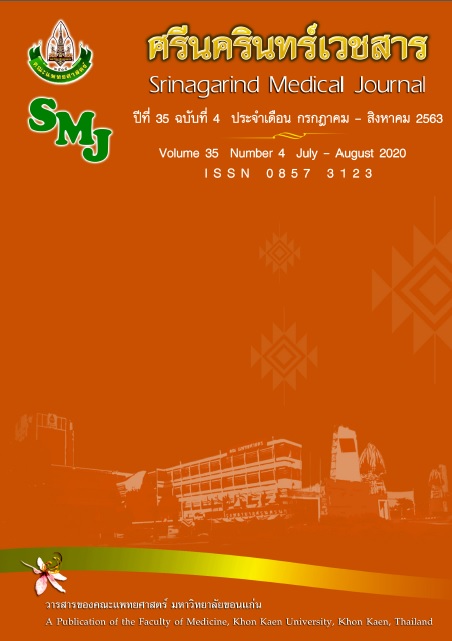ความกลัวการหกล้มในผู้สูงอายุที่เป็นโรคเบาหวานชนิดที่ 2 ที่มีและไม่มีภาวะปลายประสาทเสื่อม
คำสำคัญ:
โรคเบาหวานชนิดที่ 2; ภาวะปลายประสาทเสื่อม; ความกลัวการหกล้ม; ผู้สูงอายุบทคัดย่อ
หลักการและวัตถุประสงค์: ผู้สูงอายุที่ป่วยด้วยโรคเบาหวานชนิดที่ 2 ที่มีระดับน้ำตาลในเลือดสูงเป็นเวลานานมักส่งผลให้เกิดภาวะปลายประสาทส่วนปลายเสื่อม ซึ่งเป็นปัจจัยเสี่ยงต่อการหกล้ม จากสาเหตุการสูญเสียความรู้สึกในการป้องกันตนเองที่เท้า นอกจากนี้ภาวะปลายประสาทส่วนปลายเสื่อมในผู้ป่วยเบาหวานน่าจะส่งผลให้ความกลัวการหกล้มสูงขึ้นด้วย และนำไปสู่การจำกัดการเคลื่อนไหวในชีวิตประจำวัน อย่างไรก็ตามยังไม่มีการศึกษาความกลัวการหกล้ม ของผู้สูงอายุที่ป่วยเป็นเบาหวานชนิดที่ 2 ที่มีและไม่มีภาวะปลายประสาทเสื่อมในประเทศไทย ดั้งนั้นการศึกษาครั้งนี้จึงมีวัตถุประสงค์เพื่อเปรียบเทียบความกลัวการหกล้มในผู้สูงอายุที่เป็นเบาหวานที่มีและไม่มีปลายประสาทเสื่อม และผู้สูงอายุที่มีสุขภาพดี
วิธีการศึกษา: อาสาสมัครทั้งหมดจำนวน 114 ราย แบ่งออกเป็นกลุ่มผู้สูงอายุที่ป่วยเป็นเบาหวานชนิดที่ 2 ที่มีภาวะปลายประสาทเสื่อม กลุ่มผู้สูงอายุที่ป่วยเป็นเบาหวานชนิดที่ 2 ที่ไม่มีภาวะปลายประสาทเสื่อม และกลุ่มผู้สูงอายุที่มีสุขภาพดี จำนวนกลุ่มละ 38 ราย อาสาสมัครทั้งหมดได้รับการประเมินความกลัวการหกล้ม ด้วยแบบประเมิน Falls Efficacy Scale-International (FES-I)
ผลการศึกษา: กลุ่มผู้สูงอายุที่ป่วยเป็นเบาหวานชนิดที่ 2 ที่มีภาวะปลายประสาทเสื่อมมีความกลัวการหกล้ม (33.36 ± 6.98) มากกว่าอย่างมีนัยสำคัญทางสถิติเมื่อเทียบกับกลุ่มผู้สูงอายุที่ป่วยเป็นเบาหวานชนิดที่2 ที่ไม่มีภาวะปลายประสาทเสื่อม (24.34 ± 6.76) และกลุ่มผู้สูงอายุที่มีสุขภาพดี (16.39 ± 0.50) (p < 0.05) นอกจากนี้ผู้สูงอายุที่ป่วยเป็นเบาหวานชนิดที่ 2 ที่ไม่มีภาวะปลายประสาทเสื่อมมีความกลัวการหกล้มมากกว่ากลุ่มผู้สูงอายุที่มีสุขภาพดีอย่างมีนัยสำคัญทางสถิติ (p < 0.05)
สรุป: ผู้สูงอายุที่ป่วยเป็นเบาหวานชนิดที่ 2 ที่มีภาวะปลายประสาทเสื่อมมีความกลัวการหกล้มมากกว่ากลุ่มผู้ป่วยเบาหวานที่ไม่มีภาวะปลายประสาทเสื่อมและผู้สูงอายุที่มีสุขภาพดี ซึ่งเป็นปัจจัยเสี่ยงสำคัญต่อการหกล้มในผู้สูงอายุ
References
2. สุพัตรา ศรีวณิชชากร. สถานการณ์การป่วยและการตายด้วยโรคไม่ติดต่อเรื้อรัง (โรคเบาหวานชนิดที่ 2 และโรคหัวใจและหลอดเลือด) ในประเทศไทยในระยะ 5 ปี (2553-2557). 2560; 43: 379-90.
3. Oguejiofor OC, Odenigbo CU, Oguejiofor CB. Evaluation of the effect of duration of diabetes mellitus on peripheral neuropathy using the United Kingdom screening test scoring system, bio-thesiometry and aesthesiometry. Niger J Clin Pract 2010;13: 240-7.
4. Kelly C, Fleischer A, Yalla S, Grewal GS, Albright R, Berns D, et al. Fear of falling is prevalent in older adults with diabetes mellitus but is unrelated to level of neuropathy. J Am Podiatr Med Assoc 2013; 103: 480-8.
5. Pinheiro HA, Vilaça KHC, Carvalho GdA. Assessment of muscle mass, risk of falls and fear of falling in elderly people with diabetic neuropathy. Fisioter Mov 2015; 28: 677-83.
6. Timar B, Timar R, Gaiță L, Oancea C, Levai C, Lungeanu D. The impact of diabetic neuropathy on balance and on the risk of falls in patients with type 2 diabetes mellitus: a cross-sectional study. PLos One 2016; 11: 1-11.
7. Bokan-Mirković V, Škarić-Karanikić Ž, Nejkov S, Vuković M, Ćirović D. Diabetic polyneuropathy and risk of falls: fear of falling and other factors. Acta Clin Croat 2017; 56: 721-7.
8. Legters K. Fear of falling. Phys Ther 2002; 82: 264-72.
9. de Souza Moreira B, Dos Anjos DMdC, Pereira DS, Sampaio RF, Pereira LSM, Dias RC, et al. The geriatric depression scale and the timed up and go test predict fear of falling in community-dwelling elderly women with type 2 diabetes mellitus: a cross-sectional study. BMC Geriatrics 2016;16: 1-10.
10. Sankhe P, Ganvir S. Association between Physical Functioning and Fear of Falling with Balance in Elderly Diabetic Individuals.Physiother Rehabil 2017; 02: 1-5.
11. Tander B, Atmaca A, Ulus Y, Tura Ç, Akyol Y, Kuru Ö, et al. Balance performance and fear of falling in older patients with diabetics: a comparative study with non-diabetic elderly. Turk J Phys Med Rehab 2016; 62: 314-22.
12. Bruce D, Hunter M, Peters K, Davis T, Davis W. Fear of falling is common in patients with type 2 diabetes and is associated with increased risk of falls. Age Ageing 2015; 44: 687-90.
13. Meijer J, Smit A, Sonderen E, Groothoff J, Eisma W, Links T. Symptom scoring systems to diagnose distal polyneuropathy in diabetes: the Diabetic Neuropathy Symptom score. Diabet Med 2002; 19: 962-5.
14. สถาบันวิจัยและประเมินเทคโนโลยีทางการแพทย์ กรมการแพทย์. แนวทางเวชปฏิบัติการป้องกันและดูแลรักษาผู้ป่วยเบาหวานที่มีภาวะแทรกซ้อนที่เท้า. นนทบุรี: ชุมนุมสหกรณ์การเกษตรแห่งประเทศไทย จำกัด, 2556.
15. สมาคมโรคเบาหวานแห่งประเทศไทย. แนวเวชปฏิบัติสำหรับโรคเบาหวาน 2554. กรุงเทพมหานคร: ศรีเมืองการพิมพ์, 2554.
16. ลัดดา เถียมวงศ์. การทดสอบคุณสมบัติของเครื่องมือประเมินอาการกลัวการหกล้มในผู้สูงอายุไทย. สงขลานครินทร์เวชสาร 2554; 29: 277-87.
17. Delbaere K, Close JC, Mikolaizak AS, Sachdev PS, Brodaty H, Lord SR. The falls efficacy scale international (FES-I). A comprehensive longitudinal validation study. Age Ageing 2010; 39: 210-6.
18. de Souza Moreira B, Ferreira Sampaio R, Rossana Cavalcanti Furtado S, Correa Dias R, Noce Kirkwood R. The relationship between diabetes mellitus, geriatric syndromes, physical function, and gait: a review of the literature. Curr Diabetes Rev 2016; 12: 240-51.
19. Munshi M, Grande L, Hayes M, Ayres D, Suhl E, Capelson R, et al. Cognitive dysfunction is associated with poor diabetes control in older adults. Diabetes Care 2006; 29: 1794-9.
20. de Souza Moreira B, Sampaio RF, Diz JBM, de Carvalho Bastone A, Ferriolli E, Neri AL, et al. Factors associated with fear of falling in community-dwelling older adults with and without diabetes mellitus: findings from the Frailty in Brazilian Older People Study (FIBRA-BR). Exp Gerontol 2017; 89: 103-11.
21. Doi T, Ono R, Ono K, Yamaguchi R, Makiura D, Hirata S. The association between fear of falling and physical activity in older women. J Phys Ther Sci 2012; 24: 859-62.
22. Alam U, Asghar O, Azmi S, Malik RA. General aspects of diabetes mellitus. Handb Clin Neurol 2014; 126: 211-22.
23. Hewston P, Deshpande N. Falls and balance impairments in older adults with type 2 diabetes: thinking beyond diabetic peripheral neuropathy. Can J Diabetes 2016; 40: 6-9.
24. Kang GE, Najafi B. Sensor-Based Daily Physical Activity: Towards Prediction of the Level of Concern about Falling in Peripheral Neuropathy. Sensors 2020; 20: 1-11.
25. Litwin H, Erlich B, Dunsky A. The complex association between fear of falling and mobility limitation in relation to late-life falls: a SHARE-based analysis. J Aging Health 2018; 30: 987-1008.



